Rebounding on a mini-trampoline offers exceptional healing benefits with minimal joint stress. You'll strengthen deep core muscles, improve circulation, and build bone density while experiencing less fatigue than traditional exercises. It's particularly valuable for rehabilitation, chronic pain management, and seniors seeking balance improvement. Start with gentle bounces, proper footwear, and consider a model with handlebars for stability. The gentle G-force distribution throughout your body supports healing in ways few other exercises can match.
The Science Behind Mini-Trampoline Exercise for Recovery
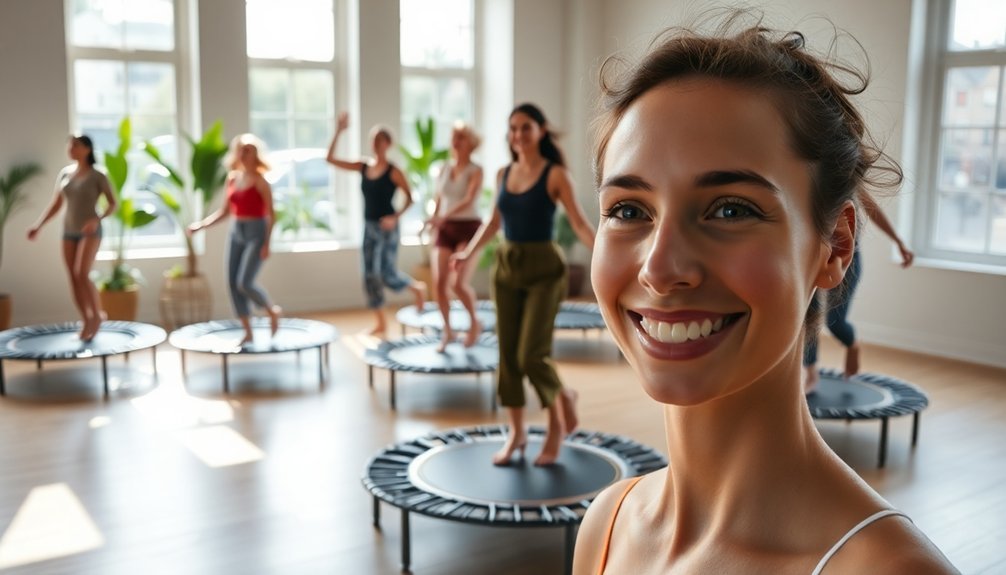
Nearly all recovery specialists now recognize the unique benefits of mini-trampoline exercise, also known as rebounding. This gentle approach offers remarkable cardiovascular advantages—studies show it's potentially 68% more efficient than running while considerably reducing joint stress.
Rebounding delivers superior cardio benefits with minimal joint impact—a perfect balance of efficiency and protection.
When you bounce, you're engaging deep core muscles and stabilizing hip joints, which can help prevent urinary incontinence. The low-impact nature makes it ideal for rehabilitation, especially for those recovering from neurological conditions like stroke, multiple sclerosis, or Parkinson's disease.
Your body responds to rebounding with improved blood circulation, enhanced oxygen delivery, and better bone mineral density—crucial for osteoporosis management. Research indicates that mini-trampoline training can significantly improve vertical jump performance by up to 13.55% after just eight weeks of consistent practice.
Most impressively, you'll experience these benefits while feeling less fatigued than with traditional exercises, as rebounding reduces perceived exertion despite delivering moderate to vigorous workout intensity.
Getting Started: Essential Rebounding Equipment for Beginners
When starting your rebounding journey, you'll want to invest in a quality rebounder with either bungee or spring-based technology that supports at least 250 pounds and stands 9 inches high for stability.
Look for models with proper safety certifications, positive customer reviews, and extensive warranties that include local support and spare parts availability. For beginners and those with special needs, bungee rebounders offer quieter and more controlled bouncing experiences.
Essential safety accessories like optional handle bars can provide balance assistance while you're building confidence and proper technique.
Quality Rebounders Matter
Investing in a high-quality rebounder can make the difference between an effective workout routine and potential injury or disappointment. Look for models that sit at least 9 inches off the ground with a weight of over 10 kg for ideal stability during your bounces.
Consider your needs carefully. If you're concerned about noise or joint impact, bungee rebounders offer a quieter, gentler bounce perfect for beginners. For more intense fitness routines, spring models provide faster tempos. Proper positioning with feet wider than hips in a mini squat stance will help maintain stability and alignment during your workouts. Brands like Fit Bounce Pro, Cellerciser, and JumpSport have established reputations for quality.
Don't overlook practical features such as foldability, handlebars for balance, and included workout resources.
Choose manufacturers that specialize in rebounding equipment and offer solid warranties with accessible customer service and replacement parts.
Essential Safety Accessories
Safety should never be an afterthought when setting up your rebounding routine. The right accessories not only enhance your exercise experience but also protect you from potential injuries.
If you're new to rebounding or have balance concerns, consider investing in stability bars or handles that provide essential support during your bouncing sessions.
- Choose proper footwear with good cushioning to protect your feet and joints while maintaining control on the trampoline surface.
- Place your rebounder on a stable, level surface away from walls and furniture to prevent accidents during your workout.
- Consider your specific needs when selecting between spring or bungee rebounders—springs offer firmer bounces while bungees provide quieter, gentler resistance.
Always guarantee you have adequate lighting and enough clear space around your equipment for safe movement. For optimal health benefits, include a variety of movements during your rebounding sessions to avoid overusing muscle groups and achieve a balanced workout.
Joint-Friendly Bouncing Techniques for Injury Prevention
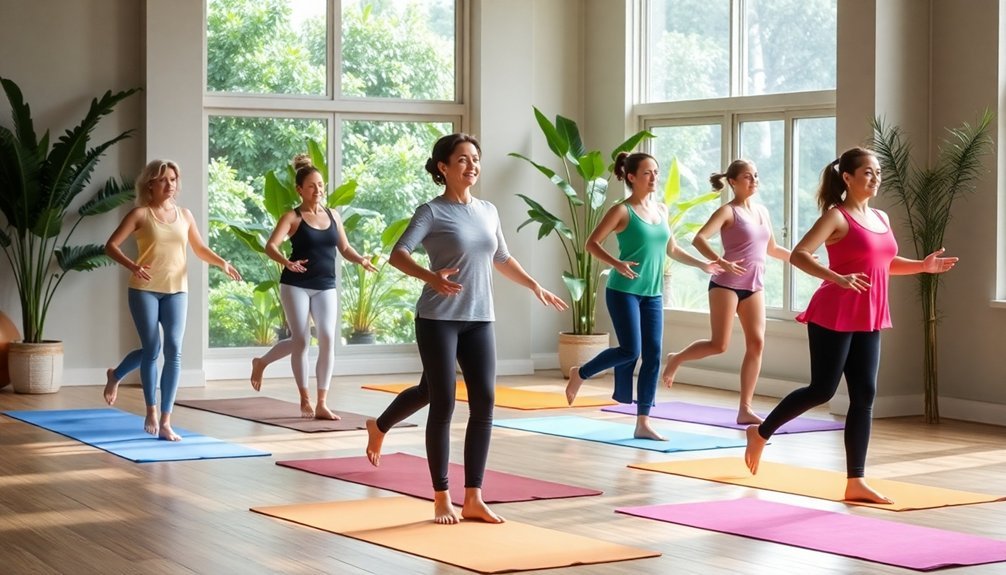
Bouncing exercises, often overlooked in fitness routines, can offer exceptional benefits while being gentle on your joints. Mini trampolines provide an excellent low-impact option you can use indoors, while water-based activities incorporate gentle bouncing movements with minimal joint stress.
Always warm up properly before starting any bouncing routine to increase blood flow and flexibility. Wear shock-absorbing shoes and consider using knee supports for additional stability. To maintain your joint health throughout these exercises, remember to stay properly hydrated during your workout sessions. Progress gradually by starting with low-impact jumps and slowly increasing intensity as your joints adapt.
For maximum protection, exercise on soft surfaces or thick mats that cushion impact. Strengthening the muscles around your joints through complementary exercises will provide better support during bouncing activities.
If you're new to these techniques, consult with a fitness professional to guarantee proper form.
Rebounding for Seniors: Safe Approaches to Improve Balance
Rebounding on mini-trampolines offers seniors far more than just improved bone density, with significant benefits for your cardiovascular health and lymphatic system.
You'll want to start with simple mini-rebounds while holding onto a stabilizing bar before progressing to more challenging movements.
Balance-focused exercises like single-leg bounces and side-to-side movements will strengthen your core muscles and dramatically improve your stability, reducing fall risk. This activity helps develop your proprioception awareness, which enhances your body's ability to sense position and movement.
Benefits Beyond Bone Density
While most fitness enthusiasts focus on rebounding's impact on bone health, its advantages for seniors extend far beyond density improvements.
You'll enjoy significant cardiovascular benefits as gentle bouncing improves circulation, lowers blood pressure, and strengthens your heart muscle—all without stressing your joints. The trampoline's flexible surface absorbs shock effectively, making it exceptionally gentle on aging bones and joints.
- Mental wellness boosts occur naturally as rebounding releases mood-enhancing endorphins, reducing stress and anxiety while providing a fun activity you'll actually look forward to.
- Enhanced muscle tone develops throughout your body, particularly in leg and core muscles that support daily mobility and independence.
- Improved neuromuscular coordination helps synchronize your movements, making everyday activities easier and reducing fall risks.
The compact nature of rebounders also makes this exercise accessible even in limited space, allowing you to maintain consistency in your fitness routine.
Starting With Mini-Rebounds
The journey into rebounding begins with selecting the right equipment and mastering foundational techniques. Choose a mini-trampoline with a sturdy mat and stable legs—brands like JumpSport offer models specifically designed for seniors.
If you're concerned about balance, look for one with an attachable support bar.
Start with the "health bounce," keeping your feet fixed on the mat while gently pushing down. Don't actually jump—you're aiming for subtle, controlled movements that engage your core muscles. For beginners, practicing low-impact rebounding with feet always in contact with the mat is an excellent way to build confidence.
Try heel raises to strengthen your calves or side-to-side steps to improve lateral stability.
Begin with just 5-minute sessions and gradually increase duration as you build confidence. Remember to focus on pushing into the mat rather than height, and always use support if needed.
Balance-Focused Rebounding Exercises
As we advance beyond the basics, balance-focused exercises become the cornerstone of an effective rebounding routine.
These specialized movements enhance your proprioceptive system while engaging multiple muscle groups simultaneously.
Try incorporating these balance-enhancing exercises into your rebounding practice:
- Side-to-Side Bounces – Shift your weight gently from one foot to the other, challenging your lateral stability and strengthening hip stabilizers.
- Heel Digs – Alternate tapping heels forward while maintaining core engagement to improve lower body coordination.
- Seated Bounces – Sit centered on the rebounder with feet flat and gently bounce to activate core muscles without standing balance requirements.
Always use stability bars when needed, and remember that consistent practice builds confidence. Focus your gaze on a fixed point ahead to maintain better stability during rebounding exercises.
Gradually increase duration as your balance improves, starting with just 10-minute sessions.
Post-Surgery Rehabilitation Through Gentle Trampoline Workouts
Recovering from surgery often requires gentle yet effective rehabilitation methods that build strength without endangering healing tissues. Mini-trampolines offer an ideal solution with their low-impact nature that reduces joint stress while promoting healing.
You'll need your doctor's clearance before starting any trampoline exercises. Begin with gentle bounces and always use handlebars for stability in early sessions. Wear supportive footwear and stop immediately if you experience pain.
Trampoline workouts boost blood circulation, enhance flexibility, and build supporting muscles—all vital for recovery. The constant movement on the trampoline surface helps strengthen proprioception skills that are essential for balance and coordination restoration. They're particularly effective for knee replacement patients, stroke recovery, and those with neurological conditions.
Unlike running, these exercises minimize impact while delivering similar cardiovascular benefits to swimming or cycling, but in a more engaging, space-efficient format.
Lymphatic System Benefits of Low-Impact Rebounding
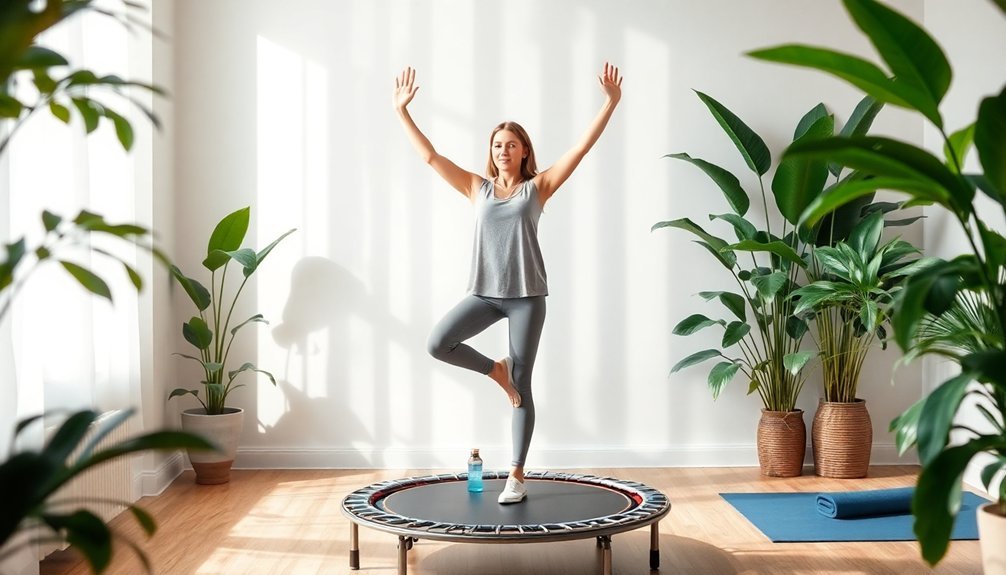
Fundamental to your overall health yet often overlooked, the lymphatic system requires regular movement to function properly, unlike the heart-driven circulatory system.
Rebounding on a mini-trampoline provides an efficient way to stimulate lymphatic flow, increasing circulation up to 15 times normal rates as you bounce.
This gentle bouncing motion repeatedly opens and closes lymphatic valves, creating a powerful detoxification effect that:
- Enhances removal of metabolic waste and toxins from your cells
- Boosts white blood cell count nearly threefold, strengthening your immune defense
- Improves cellular health while increasing mitochondrial energy production
You'll experience these benefits with minimal joint impact, making rebounding an ideal exercise choice for recovery periods or when conventional workouts aren't possible. For best results, position your feet hip-width apart while maintaining relaxed shoulders and a slight bend in your knees.
Progressive Rebounding Programs for Chronic Pain Management
When chronic pain limits your mobility options, progressive rebounding programs offer a gentle pathway back to movement and comfort. These structured approaches on mini-trampolines provide a low-impact environment where your joints experience less stress while muscles strengthen gradually. Unlike acute pain, chronic pain persists beyond the normal healing timeframe, making gentle, progressive exercise particularly important for long-term management.
| Program Phase | Duration | Key Features | Benefits |
|---|---|---|---|
| Beginner | 5-10 min | Gentle bouncing, seated exercises | Joint protection, initial mobility |
| Intermediate | 10-15 min | Standing bounces, arm movements | Increased strength, balance improvement |
| Advanced | 15-20 min | Varied movements, light resistance | Enhanced coordination, pain reduction |
| Maintenance | 20-30 min | Combined techniques, personalized routines | Sustained relief, improved function |
Always work with healthcare professionals to customize your rebounding program based on your specific condition and response to exercise. Your progress should guide adjustments in intensity and duration.
Combining Rebounding With Mindfulness for Emotional Healing
The powerful synergy between rebounding and mindfulness creates a unique pathway for emotional healing that goes beyond traditional exercise benefits. When you incorporate mindfulness into your rebounding routine, you're not just strengthening your body—you're building emotional resilience.
The rebounding-mindfulness connection transforms simple exercise into profound emotional healing—strengthening both body and inner resilience simultaneously.
The gentle bouncing motion naturally reduces cortisol levels while releasing mood-enhancing endorphins, creating an ideal state for emotional processing. The rhythmic nature of rebounding encourages a state of present-moment awareness that helps achieve mental clarity and reduces anxiety symptoms.
- Focus on your breathing rhythm as you bounce, allowing thoughts to flow without judgment
- Start with just 5-10 minutes daily, gradually increasing as you build both physical and emotional strength
- Use the rhythmic motion to enter a meditative state where you can safely explore difficult emotions
This powerful combination helps you develop greater self-awareness while building sustainable emotional coping mechanisms.
Rebounding vs. Traditional Cardio: Comparative Impact on Joints
Many fitness enthusiasts are unaware that rebounding offers a revolutionary alternative to traditional cardio workouts, particularly when it comes to joint health.
Unlike running on hard surfaces, trampolines absorb impact, distributing force evenly throughout your body and notably reducing stress on knees, ankles, and spine.
You'll experience similar cardiovascular benefits in just a third of the time – 10 minutes of rebounding equals approximately 30 minutes of running – while protecting your joints from excessive pressure.
This makes rebounding ideal if you're recovering from injuries or managing musculoskeletal conditions.
The cushioned surface creates a gentle workout environment that still effectively strengthens muscles, builds endurance, and improves balance. NASA research has confirmed that the unique gravitational pull during bouncing significantly enhances bone and muscle strength.
You'll enjoy efficient calorie burning and heart health improvements without the joint strain associated with traditional high-impact cardio exercises.
Success Stories: Real Rehabilitation Journeys Through Rebounding
Real-life success stories from rebounding enthusiasts reveal the transformative power of this gentle exercise form across various rehabilitation journeys.
Individuals recovering from ankle injuries have regained strength through progressive sit bouncing exercises, gradually rebuilding stability without risking re-injury.
- A woman who lost 28 pounds over several months combined consistent rebounding with dietary changes, finding the low-impact nature allowed her to exercise despite previous joint pain.
- One rehabilitation patient noted improved balance and flexibility after incorporating rebounding into their post-surgery recovery routine.
- A man with Tourette's Syndrome reported significant reduction in symptoms and improved mental clarity after establishing a regular rebounding practice.
Former NBA All-Star Jayson Williams integrated physical activity as a crucial component in his substance abuse recovery program, demonstrating rebounding's effectiveness beyond traditional rehabilitation methods.
These testimonials highlight rebounding's unique position at the intersection of physical recovery and mental wellness.
Medical Perspectives: What Experts Say About Therapeutic Rebounding
Medical professionals often recommend rebounding as a therapeutic exercise that offers significant benefits with minimal stress on your joints.
You'll find that many physicians endorse this approach for its ability to improve muscle tone and balance while protecting vulnerable joints from the impact typically associated with other exercises.
The gentle bouncing motion creates a healing environment where your body can strengthen without the painful consequences of high-impact activities.
Doctor-Endorsed Rebounding Benefits
Healthcare professionals worldwide have begun recommending rebounding as a therapeutic exercise option for patients with diverse health concerns. Medical doctors particularly value its capacity to improve cardiovascular health while minimizing joint stress—a significant benefit for those with mobility limitations or chronic conditions.
- Clinically Supported Benefits: Physicians cite rebounding's ability to lower blood pressure, improve insulin sensitivity, and enhance lymphatic drainage—making it valuable for patients managing diabetes, hypertension, or immune disorders.
- Physiological Advantages: Doctors note that the gentle gravitational shifts during rebounding strengthen bone density without jarring impacts, providing safer exercise options for osteoporosis patients. Studies have shown that rebounding distributes G-force consistently across the body, unlike running which concentrates impact on the ankles and joints.
- Therapeutic Applications: Medical experts recommend rebounding for rehabilitation, noting improvements in balance, coordination, and neurological function—particularly beneficial for recovery from injuries or neurological conditions.
Joint-Friendly Healing Properties
Nearly all orthopedic specialists acknowledge rebounding's exceptional joint-friendly benefits compared to traditional exercises. When you bounce on a trampoline, the flexible surface absorbs up to 80% of the impact that would normally stress your joints during activities like running or jumping on hard surfaces.
| Joint Benefit | How It Works | Who Benefits Most |
|---|---|---|
| Pain Reduction | Even pressure distribution across body | Arthritis patients |
| Enhanced Mobility | Gentle, rhythmic movement | Post-surgery recovery |
| Injury Prevention | Strengthens supporting muscles | Athletes & seniors |
Your joints receive therapeutic movement without harmful stress, making rebounding ideal for rehabilitation. The consistent, low-impact nature of this exercise promotes improved circulation to joint tissues while simultaneously building bone density—a rare combination that supports long-term joint health and can greatly reduce your risk of future injuries. Regular rebounding sessions have been shown to effectively lubricate joints, reducing pain and stiffness especially in older adults.
Frequently Asked Questions
How Does Rebounding Affect Blood Pressure and Cardiovascular Conditions?
Rebounding lowers your blood pressure by improving circulation and reducing artery clogging. You'll strengthen your heart, separate sticky blood cells, and enhance oxygen delivery while enjoying a low-impact exercise that's safe for pre-existing conditions.
Can Rebounding Help With Specific Types of Arthritis?
Yes, rebounding can help with osteoarthritis, rheumatoid arthritis, and psoriatic arthritis by providing low-impact exercise that improves joint function, reduces pain, and strengthens muscles without putting excessive stress on your joints.
What Clothing and Footwear Are Best for Rebounding Exercises?
Wear comfortable, loose-fitting clothes made from breathable fabrics. You'll benefit from non-slip athletic shoes with good arch support, or try rebounding barefoot for better surface connection if you're comfortable doing so.
How Does Rebounding Compare to Aquatic Therapy for Rehabilitation?
Both rebounding and aquatic therapy offer low-impact rehabilitation benefits. You'll experience reduced joint stress with both, but aquatic therapy provides better buoyancy for severe mobility issues while rebounding improves coordination and balance more effectively.
Are There Contraindications for Rebounding During Certain Medical Treatments?
Yes, you shouldn't rebound during treatments for heart conditions, after surgery, with brittle bones, during pregnancy, or with neurological issues like epilepsy. Always consult your doctor before starting any exercise program.
In Summary
You've now discovered how a mini-trampoline can transform your recovery journey. Whether you're healing from surgery, managing joint pain, or simply seeking low-impact exercise, rebounding offers a gentle yet effective solution. It's more than just physical therapy—it's a path to renewed strength, improved balance, and emotional wellbeing. Start slowly, listen to your body, and you'll bounce back stronger than before.



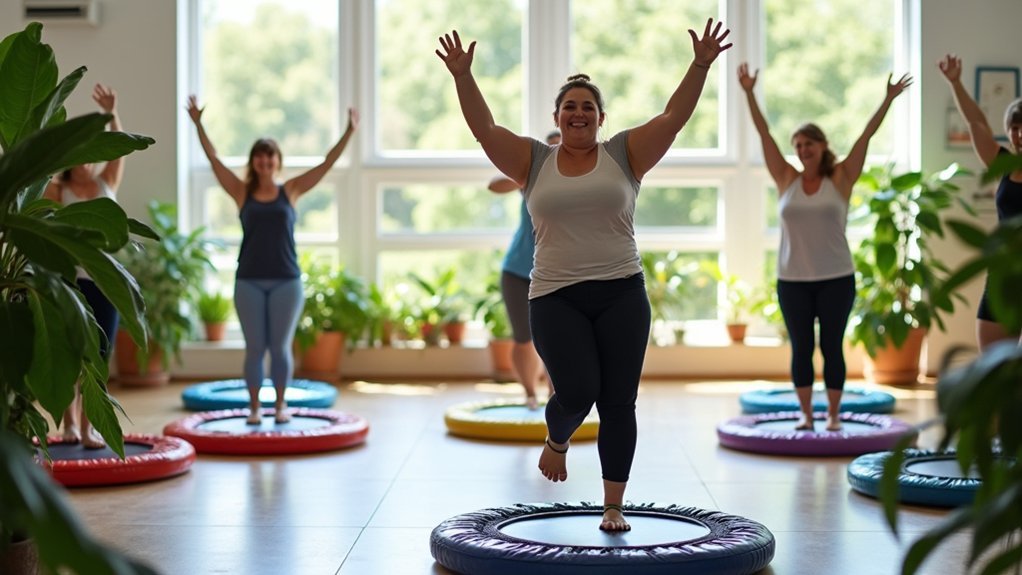
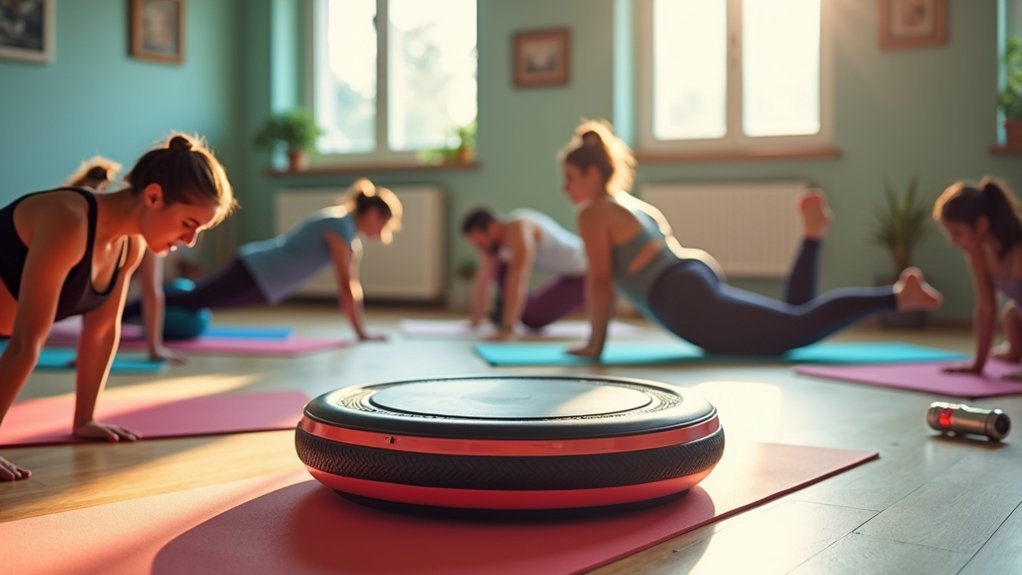
Leave a Reply